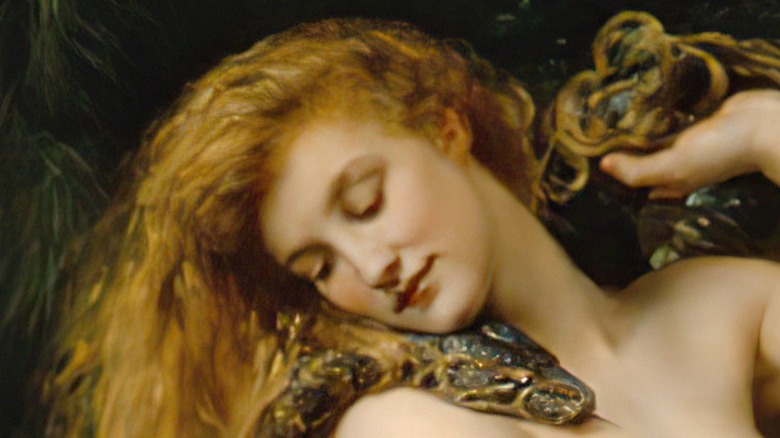Does Lilith Appear In The Bible?
The figure of Lilith (portrayed by artist John Collier in the 1892 painting above) is sometimes referred to as "Adam's first wife," as in Adam, the Biblical figure who was the first human being created by God. Along with his wife, Eve, Adam was ultimately deemed responsible for human beings being ejected from the Garden of Eden.
Per Britannica, Lilith's origins come from Jewish folklore, rather than the Bible. Her name comes from the class of Mesopotamian demons called "lilû" or "lilītu" and is generally translated as "night monster." While Eve was created from Adam's rib in Genesis 2:22, some have interpreted Genesis 1:27 ("So God created mankind in his own image, in the image of God he created them; male and female he created them," as quoted by Bible Gateway) to refer to Lilith as the female whom God created from the Earth, like Adam.
According to the Jewish Women's Archive, the only mention of the word or name Lilith in the Bible appears in Isaiah 34:14, which Sefaria quotes as "Wildcats shall meet hyenas, / Goat-demons shall greet each other / There too the lilith shall repose / And find herself a resting place." (Depending on the translation, the name might not appear at all — for instance, there's no mention of Lilith in the King James Version.) The JWA notes that within ancient Babylonian religion, the lilû and lilītu used to be humans who had died young and came in through windows looking for victims to make up for the wives and husbands they never had.
Lilith: from feared demon to feminist figure
According to the Jewish Women's Archive, eventually the lilû and lilītu demon figures were combined with that of the demon Lamashtu, who was said to have threatened newborns and enjoyed the taste of human flesh and blood. Liliths were often featured as drawings on Aramaic incantation bowls from the Sasanian Empire and early Islamic Iraq and Iran circa 400-800 B.C. intended to exorcise demons from a home or person's body or reverse ill-intended magic.
The medieval Jewish text the Alphabet of Ben Sira portrays Lilith as Adam's first wife who argues with Adam and declares that they are equal because they were both created from the Earth by God. She eventually flies away into the air, refuses to return to Adam even after God sends angels after her, and declares she was only created to make newborn babies sick. Angels make a deal with her: She doesn't have to return to Adam, but must leave babies alone when she sees an amulet inscribed with the angels' names and likenesses.
In 1972, writer Lilly Rivlin published and article in Ms. magazine (available on her personal website) reclaiming the legend of Lilith from that of a demon to that of a "female archetype which is creative and self liberating." The Jewish feminist magazine Lilith began publishing in the fall of 1976, and just over 20 years later, singer Sarah McLachlan (above) would name her female-focused traveling music festival Lilith Fair, suggested by her friend, writer Buffy Childerhose, who taught her the history of Lilith as a feminist figure, per Vanity Fair.

